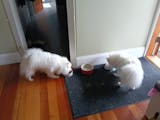Crate training can be an effective way to help your dog learn good behaviour and become more comfortable in their living space. Here are some tips for crate training your dog:
- Choose the right size crate: The crate you use should be big enough for your dog to stand up, turn around, and lie comfortably. If the crate is too big, your dog may use one end as a bathroom, which defeats the purpose of crate training.
- Make the crate a positive space: The crate should be a comfortable and safe space for your dog, not a punishment. Put a soft bed or blanket in the crate, and ensure the crate is in a quiet and well-ventilated area.
- Introduce the crate gradually: Don't just put your dog in the crate and expect them to be happy about it. Instead, introduce the crate gradually and make it a positive experience. Start by leaving the door open and encouraging your dog to explore the crate on its own. You can also put treats or toys in the crate to make it more appealing.
- Don't force your dog into the crate: If your dog is hesitant to go into the crate, don't try to force them. Instead, try to make the crate more appealing by using treats or toys, or try moving the crate to a different location. If your dog still refuses to go into the crate, you may need to take a step back and try again later.
- Start with short periods in the crate: Once your dog is comfortable going into the crate, you can start closing the door for short periods. Start with just a few minutes and gradually increase the time as your dog becomes more comfortable. Be sure to let your dog out as soon as they start to whine or bark, as this can reinforce the behaviour and make it harder to crate train them.
- Don't use the crate as a punishment: The crate should be a positive space for your dog, not a punishment. Never use the crate to discipline your dog or isolate them when they've done something wrong. This can create negative associations with the crate and make it harder to crate train your dog.
- Be consistent: Crate training can take time and patience, but it's essential to be consistent and stick to a routine. Establish a regular schedule for putting your dog in the crate and letting them out, and make sure everyone in the household follows the same rules. This will help your dog understand what is expected of them and make the crate training process smoother.
Following these tips can help your dog become comfortable and happy in their crate, which can be a valuable tool for training and behaviour management. Remember to be patient and consistent and to make the crate a positive space for your dog.
















